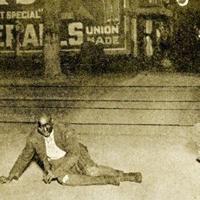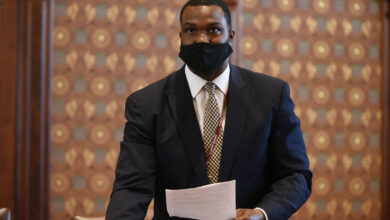Race hatred, workforce tensions explode in East St. Louis in 1917

EAST ST. LOUIS • Land was flat and plentiful. Cheap coal was just up the hill. Low-wage workers were easy to find.
Once a quiet ferry landing on the east bank of the Mississippi River, this town burst with growth in the late 19th Century. Industrialists built sprawling factories across the formerly swampy expanse of the American Bottom. Workers lived in drab houses nearby. It was a gritty town, but there was plenty of work.
East St. Louis, briefly called Illinoistown after its incorporation in 1859, was home to only 5,600 people in 1870. Then came the National Stockyard in 1873 and the Eads Bridge one year later. The city became a tangle of 22 railroads connecting St. Louis to the north, east and south.
By 1910, with 58,000 residents, the city and environs were home to many industries that burned mountains of sooty coal from nearby Illinois mines. The big payrolls included Aluminum Ore Co., American Steel Foundry, Republic Iron & Steel, Obear Nester Glass and Elliot Frog & Switch (a frog was part of a railroad switch).
People are also reading…

A scene from the noon hour at Obear Nestor Glass Co. in East St. Louis, where children were among the employees. This May 1910 photo was taken by Lewis Wickes Hine, who was documenting child labor practices around the country. Library of Congress image.
Many of the factories were built just beyond the city limit to avoid municipal taxes, which helped keep city services shoddy and corrupt.
The adjoining town of National City was home to the stockyards and packing houses, including Armour and Swift. It handled nearly 5 million pigs annually and was the nation’s biggest market for horses and mules.
The accounts hold back nothing in terms of graphic detail and gore. Even today, this reporting must run with a disclaimer cautioning readers t…
World War I created a bonanza for the draft-animal trade. It made American industry hum. And it aggravated social conflict that exploded in shocking violence in summer 1917.
Thousands of black people from the South moved north to work in war factories. East St. Louis’ black population, 6,000 strong in 1910, nearly doubled by 1917.
That spring, the largely white workforce at Aluminum Ore, 32nd and Missouri avenues, went on strike. Management hired strikebreakers, both black and white. Embittered union leaders remembered black faces, and they demanded that City Hall “get rid” of the newcomers.
Tension already was raw when white men in a Ford shot into black homes on the night of July 1. Armed black men gathered at Bond Avenue and 10th Street and fired onto an oncoming Ford, killing two people who turned out to be police officers arriving to investigate.
The next morning, whites poured from a tense meeting in the Labor Temple downtown and began beating and killing blacks.
Rampaging white men used guns, rocks, pipes and nooses. White women egged them on, sometimes taking part. Rioters set fires in black neighborhoods and torched the Broadway Opera House on the false tale that blacks were hiding there.
Many fled to St. Louis across the Eads and Municipal (MacArthur) bridges. East St. Louis police stood by or joined the carnage. Illinois National Guard soldiers who were hustled to town did little to protect people until late in the day.
On July 3, the Post-Dispatch ran a harrowing account by Carlos F. Hurd, the reporter who scooped the world with interviews of Titanic survivors five years before. Hurd wrote that he witnessed the “massacre of helpless negroes” on streets where “a black skin was a death warrant.”
More than 300 homes and businesses were burned. The local investigation was inept, so it’s hard to know the full scope of the carnage. The official death count was 39 blacks and nine whites, but the toll probably was closer to 100.
Factories begged black workers to return, but many didn’t. When schools reopened, black enrollment was down by more than half. A lengthy congressional investigation, reporting one year later, described the riot as “savagery.”

A scene on Collinsville Avenue in downtown East St. Louis at Illinois Avenue (now Dr. Martin Luther King Drive) in 1919, two years after the riot. Lena Cook’s husband and son were dragged from a streetcar by a white mob at that intersection and shot to death during rioting on July 2, 1917. Cook, of St. Louis, later testified in court against the killers. Image courtesy St. Clair County Historical Society
Lena Cook sees her family murdered, testifies against killers
Lena Cook and her family were taking a streetcar home to St. Louis from a fishing outing in Illinois. The car reached downtown East St. Louis as angry whites were on the rampage.
Her husband, Edward, and her son, Lurizza Beard, 14, were pulled from the streetcar and shot to death. A white bystander, hardware merchant William Keyser, also was killed, probably by the same shot that passed through Lurizza.
St. Clair County authorities eventually charged more than 140 people, most of them white and including police officers and East St. Louis Mayor Fred Mollman. Indictments against the officers were “lost,” and the charge against the mayor was dropped.
But 21 people were convicted of serious crimes, including two white men in the murder of Keyser. Those verdicts came after the brave testimony of Lena Cook, who never wavered against racist cross-examination.
Newspaper files have no mention of verdicts in the murders of Cook’s husband and son.
St. Louis official opens city shelter to fleeing families
There were few heroes in the East St. Louis riot. One man who tried to help was Louis Aloe, president of the St. Louis Board of Aldermen.

Louis P. Aloe, president of the St. Louis Board of Aldermen from 1916 to 1923. As acting mayor during the race riot in East St. Louis on July 2, 1917, he opened the city’s homeless shelter to hundreds of black people who fled their homes to safety across the Mississippi River. The photo was taken in 1925, when he sought the Republican mayoral nomination. He died in 1929 at age 61. Post-Dispatch file photo
East St. Louis Mayor Fred Mollman cowered in his office during the carnage. Illinois National Guard Col. Stephen Tripp found time to step out for lunch.
Thousands of blacks fled to St. Louis, where Aloe was filling in for Mayor Henry Kiel. Aloe opened the city’s Municipal Lodging House, a homeless shelter across 12th Street (Tucker Boulevard) from City Hall, and approved emergency spending for food.
For the next week, the Lodging House provided overnight shelter to about 700 men, women and children, and fed more than 7,500. The local Red Cross assisted. Refugees, including at least one man with a gunshot wound in his back, were treated at City Hospital.
In 1923, Aloe was a driving force in an $87 million city bond issue that included money for clearing land along Market Street. He is namesake of Aloe Plaza, across from Union Station. His widow, Edith, donated money for the “Meeting of the Waters” fountain.
Louis Aloe died in 1929 and is buried in Mount Sinai Cemetery.
Photos from the archive: The 1917 East St. Louis race riots
East St. Louis riot, 1917

A white mob surrounds a street car during the riots in East St. Louis in 1917. Racial tension that brewed as black workers moved here from the South for jobs, sometimes working as strikebreakers, boiled over in July. White mobs shot and beat blacks, including children, as police officers and state militiamen largely stood by. The official death count was 39 blacks and nine whites, although police estimated a death toll closer to 100. Nobody knows, largely because local investigations were inept. Image courtesy W.E.B. Du Bois Papers, Special Collections and University Archives, University of Massachusetts Amherst.
East St. Louis race riot: victim

A victim of white rioting in East St. Louis. (Southern Illinois University Edwardsville, Bowen Archives)
Flames near East St. Louis city library

Fire burns on the night of the riot in East St. Louis near the city library, at Eighth Street and Broadway. (Missouri History Museum)
Fires from riots, as seen from Eads Bridge

Smoke rises from fires set by white mobs in East St. Louis during the riot on July 2, 1917. The caption that ran with this picture on July 3, 1917, in the St. Louis Star notes it was taken the evening of July 2 from Eads Bridge. Rioters burned more than 300 black homes and businesses. At least 39 blacks and nine whites were killed during the rampage, but the total probably was closer to 100. Rioters dumped many bodies of their black victims into Cahokia Creek. (Southern Illinois University Edwardsville, Bowen Archives)
Refugees from the 1917 East St. Louis race riot

Group portrait of African-American refugees on the streets of East St. Louis after the 1917 race riot. Photo by the St. Louis Star. Phootograph is part of the Special Collections and University Archives, University of Massachusetts Amherst Libraries
East St. Louis residents flee the city in 1917

East St. Louis residents flee across the river to St. Louis in search of refuge during the riots in 1917. Photo from Missouri Historical Society
Refugees gather in St. Louis shelter

People who fled East St. Louis to St. Louis gather for assistance. The photograph does not include information on the location, but St. Louis opened its Municipal Lodging House, a shelter across from City Hall, to refugees from the riot. (Missouri History Museum)
1917 East St. Louis race riot, destruction

Police and others look for bodies after the riot in East St. Louis. This photo ran in the St. Louis Star on July 3, 1917, with the caption: “Where the charred bodies of eight negroes burned in their homes at Eighth street and Broadway, were found today. This is the section in which the black inhabitants either ran from their homes and were slain or remained inside [and died]. An early morning crowd is inspecting the ruins.” Local investigations were inept, making accurate an death count improbable. The bodies of some black victims were buried in a common grave. Others were thrown into Cahokia Creek, which ran between downtown and the riverfront railyards. (Southern Illinois University Edwardsville, Bowen Archives)
Narcis Gurley, victim of East St. Louis race riot

Narcis Gurley, 70, with burns to her arms. She was afraid to leave her burning house in East St. Louis until the blazing walls collapsed. (Southern Illinois University, Bowen Archives)
Mineola McGee, victim of East St. Louis race riot

Mineola McGee, one of the victims of the riot in East St. Louis. A caption accompanying the original photo says her arm had to be amputated because she had been shot. (Southern Illinois University Edwardsville, Bowen Archives)
Collinsville Avenue in East St. Louis, 1919

A scene on Collinsville Avenue in downtown East St. Louis at Illinois Avenue (now Dr. Martin Luther King Drive) in 1919, two years after the riot. Lena Cook’s husband and son were dragged from a streetcar by a white mob at that intersection and shot to death during rioting on July 2, 1917. Cook, of St. Louis, later testified in court against the killers. Image courtesy St. Clair County Historical Society
Congressional committee

Members of a special Congressional committee investigating the riot meet in East St. Louis in October and November 1917 to take testimony. In July 1918, the committee released a report blaming the riot upon manipulative industrialists, corrupt local officials and the “savagery” of the white mob. Image courtesy Southern Illinois University, Bowen Archives
New York silent protest march after East St. Louis race riot

Silent Protest parade on Fifth Avenue, New York City, July 28, 1917, in response to the East St. Louis race riot. In front row are James Weldon Johnson (far right), W. E. B. DuBois (2nd from right), Rev. Hutchens Chew Bishop, rector of St. Philip’s Episcopal Church (Harlem) and realtor John E. Nail.
























































